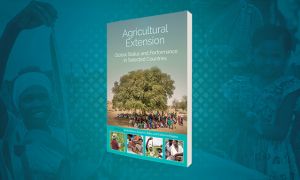Engaging young agripreneurs in private sector extension and advisory services (EAS) is critical for livelihoods in rural areas where millions of youth are unemployed and face many barriers to entry into agriculture.
Search
Engaging young agripreneurs in private sector extension and advisory services (EAS) is critical for livelihoods in rural areas where millions of youth are unemployed and face many barriers to entry into agriculture.
Implementation of decentralized and pluralistic policies in provision of extension services has led to increased availability of actors providing extension services to farmers in most developing countries including Kenya.
There is increasing concern that the COVID-19 pandemic will have dire consequences for food security unless adequate safeguards are established.
In line with the Maputo Declaration that established the Comprehensive Africa Agriculture Development Programme (CAADP) in 2003 and with the 2014 Malabo Declaration, African Union (AU) Member States pledged to conduct a continentwide Biennial Revi
Despite a rapidly growing enthusiasm for the use of information and communications technologies (ICTs) in developing country agriculture, many questions remain on the effectiveness of ICT-based approaches.
Extension and Advisory Services (EAS) providers are important partners for communities to prepare for, respond to, and recover from shocks such as natural disasters and human, plant, and animal disease and pest outbreaks.
The agricultural sector in Nigeria is characterized by low productivity that is driven in part by low use of modern agricultural technologies.
Crop productivity and potential
Chapter 3, “Crop Productivity and Potential,” documents and explains the causal factors for the rapid expansion in crop production in Ethiopia (official estimates show an increase in production of grain crops from 16.1 million metric tons to 30.6
Malawi
A number of initiatives are being implemented in response to this identified need.
As seen in Chapter 2, extension has evolved over the decades in various ways: in terms of its governance structure, in terms of who provides extension, in terms of capacity (staffing) and management, and in terms of advisory methods.
How can extension services best help small farmers meet today’s challenges? This global study points to ways to improve outcomes, enhance financial sustainability, and achieve greater scale.
Brazil
This chapter examined perceptions of family farmers and extensionists regarding extension services resulting from the agricultural extension policy in Brazil.
Ethiopia
This chapter takes stock of the provision of extension services in line with the country’s development and suggests ways such services might contribute to accelerating agricultural growth and poverty reduction in the years ahead.
This chapter is a landscape view of extension globally. It compares the recent status to the situation several decades ago, when earlier global assessments were conducted.
Uganda
The objective of this chapter is to contribute to the policy debate on the changing landscape of agricultural extension and advisory services in Uganda.
Conclusions and policy implications
The two objectives of this book are to assess extension and advisory services in a cross-country comparative context in the following ways: 1.
Democratic Republic of the Congo
This chapter analyzes the provision of agricultural extension and advisory services in the Democratic Republic of the Congo (DRC) in the context of a postconflict country and the experiences and challenges in reconstituting an extension system.
Introduction and motivation
Agricultural development is critical to the livelihoods of more than a billion small-scale farmers and other rural populations in developing countries.
Agricultural transformation and development are critical to the livelihoods of more than a billion small-scale farmers and other rural people in developing countries.

